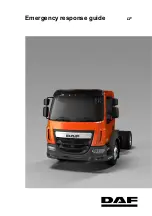
63 / 123
4.2.7. Blast Valve
Blast valve
If the pressure of the blast valve (1) ex-
ceeds the set value for any reason, the
pressure safety valve on it is activated
and secures the tank.
4.2.8. Jet Air Line
Jet air line supports discharging of the
material from the discharge hole. The
material that has reached the discharge
hole discharges quickly by the help of
the jet air. A jet air free blowing mecha-
nism is available in the vehicle to dis-
charge the material remaining in the
elbow after the discharging operation is
completed.
Opening
jet
air
free
blowing
mechanism:
Remove the coupling at the end of the
jet air line (1) and connect it to the com-
pressor. Bring the lever (2) of the ball
valve to open position.
Jet air free blowing mechanism
Closing
jet
air
free
blowing
mechanism:
After removing the remaining material,
bring the lever (2) of the ball valve to
closed position, remove the compressor
connection and install the coupling to the
end of the jet air line again.
As an option, pneumatic blowing mecha-
nism is also provided.
Opening jet air pneumatic blowing
mechanism:
Bring the lever (3) of the ball valve to
open position.
Closing jet air pneumatic blowing
mechanism:
After removing the remaining material,
bring the lever (3) of the ball valve to
closed position.
Jet air pneumatic blowing mechanism
If the material that has remai-
ning in the discharge hole is
not removed, it may thicken
and block the discharge hole.
4.2.9. Top Air Line
A top air line that enters the tank right
before the hose carrier is available on
the side air line. The entering point of the
air line may vary according to the con-
struction of the vehicle. The air entering
into the tank via the top air line both
keeps inside of the tank pressurized and
mixes inside of the tank to ensure that
the product is discharged completely
and easily. The butterfly valve (2) on the
top air line shall be opened and the ball
valve (3) shall be brought to the closed














































